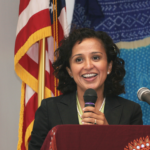What can nonprofits do to reduce poverty in Southern California? What should they not do?
Hernandez Poverty Q5

Non-profit organizations should not shy away from their right to advocate for policies that are in line with accomplishing their mission. Many organizations that provide direct services are in the best position to advocate for their clients and hold government accountable to spending our public dollars most effectively. Yet many don’t know how or don’t choose to interact with law makers. They may be worried about alienating donors or skirting rules designed to keep non-profits from engaging in political activities. But we hope more non-profits see how public policy can have a huge impact on the populations they serve and the problems they are trying to solve.
Nonprofit organizations should take the lead to partner with business advocacy groups, such as BizFed to help increase awareness of the drivers of poverty and educate our community to take action. Through coalition building, nonprofits can advocate for groundbreaking legislation that will benefit disadvantaged communities and populations gain access to the critical health, housing and education services needed.
Furthermore, nonprofits can mobilize to advocate against cuts to anti-poverty programs that help thousands of families put food on the table and help obtain health insurance. Nonprofits can continue to build relationship with local, state, and federal elected officials, engage in the media, and help implement critical anti-poverty programs.
McKellogg Poverty Q5

California is the home of a large and forward-thinking private philanthropic and social impact investing sector. However, private philanthropic initiatives are rarely well-integrated with public sector objectives and resources. Government should partner with private-sector and local stakeholders to support effective, evidence-based, and replicable nonprofit-run program models for revitalizing local innovation ecosystems and fostering inclusive economic growth, particularly in low-income and rural areas of the country.
Nonprofits should advocate for government contract rate-setting that enable them to provide ‘good jobs’ (wages, benefits, working conditions) to their employees. As nonprofits, we also need to spend more time listening to the voices of those we purport to serve and be willing to change the way we design and deliver services to align better with community needs.
Kulkarni Poverty Q5

Nonprofits in Southern California can play a pivotal role in reducing poverty by a) helping community members access and utilize public benefit programs such as Medi-Cal, CalFRESH, WIC, and SSI as well as programs that housing assistance or rental; b) conducting research that offers long term solutions, including positive changes for immigrant communities and communities of color and c) advocating at the federal, state and local level for universal health care and free tuition at public universities along with rent control and a move away from mass incarceration in addition to an increase in minimum wage and supportive housing for the homeless.
Campbell Poverty Q5

General job-skills training, shelter, and day care can be offered by non-profits. Their efficiency is much greater than that of government; so government should help with the financing, but not attempt to take over tasks being better performed by the non-profits. Non-profits should be exempt from many of the impact fees imposed on new home construction, and from government rules that impede their performing their functions. Second Harvest was twice told it had to pay volunteers more than the bag of groceries they were giving to those in need who wanted to do some work in return–because the value of the groceries, divided by the hours worked, was below the minimum wage! What was wrong with a person in need, who wants the dignity of giving something in return for what they receive, to be permitted to do so?
Rutherford Poverty Q5

Nonprofits can play a pivotal role in helping reduce poverty by offering programs to help people learn about financial literacy and develop family, life and job skills they need to find and maintain employment.
In addition, nonprofits such as Big Brothers Big Sisters of the Inland Empire connect at-risk young people with mentors who can encourage them and help build their self-confidence and resiliency. Research has shown that young people who have mentors are less likely to drop out of school or use drugs and alcohol, and they are more likely to graduate from high school and continue their education.
We also need more nonprofits that provide affordable child care for working parents. In order for most parents to work outside the home, they need access to child care. The high cost of child care leads some low-income parents to choose not to work, which makes it harder for their families to pull themselves out of poverty.
Painter Poverty Q5

Nonprofits can work to uplift the voice of the community to identify the critical needs that communities have and to help shape the changes that are needs in our existing political and economic systems. They can also provide stabilizing supports for community members in poverty
Foo Poverty Q5

Nonprofits can go beyond providing services and basic needs. Nonprofits should be integrating nonpartisan civic engagement into their settings and support community and neighborhood leadership to help transform policies and systems that create barriers and challenges to get out of poverty. Also, nonprofits can help to develop the next generation of leaders who will work in partnership with policymakers and local governments to create comprehensive change on a local level.
Bradbard Poverty Q5

There are many outstanding nonprofits addressing the effects of poverty across Southern California. Like my own organization, the Hope Through Housing Foundation, it is important for nonprofits to address the multiple challenges facing families in poverty. Working with families in affordable housing, we recognize the need to (1) prepare at-risk youth for future self-sufficiency through afterschool programs, role modeling, and teen clubs and (2) to empower parents to gain employment and build money management skills that lead to greater financial independence. One-on-one coaching has been particularly effective in addressing residents’ individual assets and challenges and helping them build a plan and the tools to improve their lives. As a result, we see residents going back to school, gaining employment, and becoming first-time homeowners, and youth becoming the first in their family to attend and finish college – a major step in breaking the cycle of generational poverty.
Buiza Poverty Q5

1) Address the scarcity model of fundraising with philanthropy so that we can all focus on how to really pursue our mission rather than being constantly beset by how we can sustain our budgets at any given year.
2) Create and collaborate on joint capital campaigns that involves state funding for civil society organizations looking to address endemic poverty.
3) Move from a model of competition and mission creep to collaboration.
Bornstein Poverty Q5

Kotkin Poverty Q5

These last two questions are almost identical. I will only answer once. Non-profits often promote a “victim agenda” that does no good for anyone but professional protesters. They need to focus on things such as training for jobs and also stand up to the regulatory state. There is much they can do in education, for example by expanding and promoting magnet and charter schools. But since most non-profits are controlled by the gentry, they prefer to put their resources into things like climate change, racial redress and gender issues, which, while important, don’t address the fundamental challenge of poverty.
Jordan Poverty Q5

I can say from my perspective and from the perspective of my organization that we believe working to reduce wasteful spending on ineffective prisons and reallocating those dollars back into communities is certainly a key to ensuring communities are healthy and thriving. For far too long, mass incarceration has had a socially and economically destabilizing impact, in large part by robbing resources from communities that needed them most and pouring them into jails and prisons that did little, if anything, to make us safe. By working with Californians from all walks of life to replace prison and justice system waste with common sense solutions that create safe neighborhoods and save public dollars, we are helping to reform systems that have kept people mired in poverty for generations.
Now is the time for us to continue to press forward. California has been a national leader on reducing incarceration and redirecting the justice system so it more effectively focuses on prevention. It is imperative that the non-profit community in Southern California and across the state come together to keep California moving forward.
Swaim Poverty Q5

There’s no single top-down solution. It’s a big state with a lot of problems — and that will require many people voluntarily pursuing their own best goals. We’re working on creating workplace freedom for California’s public employees.
Salas Poverty Q5

Non profits can help ensure that individuals are accessing the services that are available to them to get out of poverty. Non-profits should be advocating for the policies and budget allocations necessary to ensure that these services are available the community. Non-profits can also advocate to change policies that are countering poverty reduction and instead advocate for policies at the state, local and regional level that will promote holistic opportunity for all. Non-profits should not do that which the government is responsible for doing for its constituents.